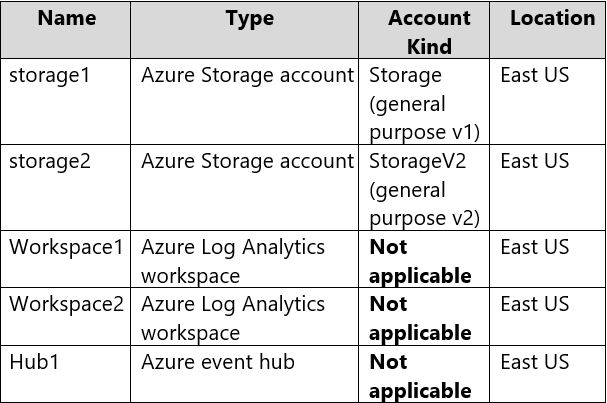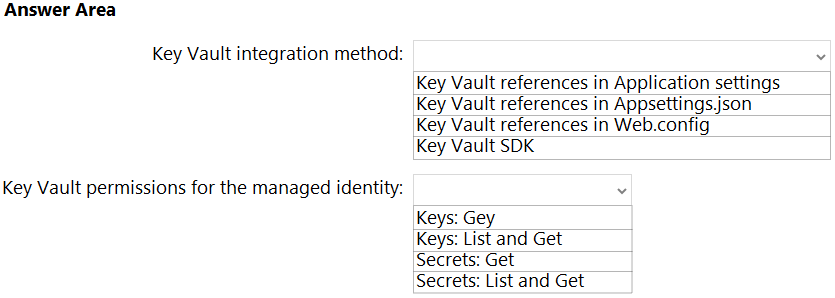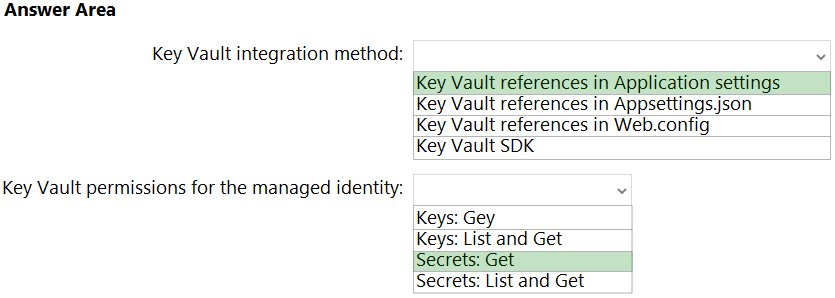Microsoft AZ-305 Exam Practice Questions (P. 5)
- Full Access (286 questions)
- Six months of Premium Access
- Access to one million comments
- Seamless ChatGPT Integration
- Ability to download PDF files
- Anki Flashcard files for revision
- No Captcha & No AdSense
- Advanced Exam Configuration
Question #21
HOTSPOT -
You have an Azure subscription that contains the resources shown in the following table.

You create an Azure SQL database named DB1 that is hosted in the East US Azure region.
To DB1, you add a diagnostic setting named Settings1. Settings1 archive SQLInsights to storage1 and sends SQLInsights to Workspace1.
For each of the following statements, select Yes if the statement is true. Otherwise, select No.
Hot Area:

You have an Azure subscription that contains the resources shown in the following table.

You create an Azure SQL database named DB1 that is hosted in the East US Azure region.
To DB1, you add a diagnostic setting named Settings1. Settings1 archive SQLInsights to storage1 and sends SQLInsights to Workspace1.
For each of the following statements, select Yes if the statement is true. Otherwise, select No.
Hot Area:

Correct Answer:

Box 1: Yes -
A single diagnostic setting can define no more than one of each of the destinations. If you want to send data to more than one of a particular destination type (for example, two different Log Analytics workspaces), then create multiple settings.
Each resource can have up to 5 diagnostic settings.
Note: This diagnostic telemetry can be streamed to one of the following Azure resources for analysis.
* Log Analytics workspace
* Azure Event Hubs
* Azure Storage
Box 2: Yes -
Box 3: Yes -
Reference:
https://docs.microsoft.com/en-us/azure/azure-monitor/essentials/diagnostic-settings https://docs.microsoft.com/en-us/azure/azure-sql/database/metrics-diagnostic-telemetry-logging-streaming-export-configure?tabs=azure-portal

Box 1: Yes -
A single diagnostic setting can define no more than one of each of the destinations. If you want to send data to more than one of a particular destination type (for example, two different Log Analytics workspaces), then create multiple settings.
Each resource can have up to 5 diagnostic settings.
Note: This diagnostic telemetry can be streamed to one of the following Azure resources for analysis.
* Log Analytics workspace
* Azure Event Hubs
* Azure Storage
Box 2: Yes -
Box 3: Yes -
Reference:
https://docs.microsoft.com/en-us/azure/azure-monitor/essentials/diagnostic-settings https://docs.microsoft.com/en-us/azure/azure-sql/database/metrics-diagnostic-telemetry-logging-streaming-export-configure?tabs=azure-portal
send
light_mode
delete
Question #22
You plan to deploy an Azure SQL database that will store Personally Identifiable Information (PII).
You need to ensure that only privileged users can view the PII.
What should you include in the solution?
You need to ensure that only privileged users can view the PII.
What should you include in the solution?
- Adynamic data maskingMost Voted
- Brole-based access control (RBAC)
- CData Discovery & Classification
- DTransparent Data Encryption (TDE)
Correct Answer:
A
Dynamic data masking limits sensitive data exposure by masking it to non-privileged users.
Dynamic data masking helps prevent unauthorized access to sensitive data by enabling customers to designate how much of the sensitive data to reveal with minimal impact on the application layer. It's a policy-based security feature that hides the sensitive data in the result set of a query over designated database fields, while the data in the database is not changed.
Reference:
https://docs.microsoft.com/en-us/azure/azure-sql/database/dynamic-data-masking-overview
A
Dynamic data masking limits sensitive data exposure by masking it to non-privileged users.
Dynamic data masking helps prevent unauthorized access to sensitive data by enabling customers to designate how much of the sensitive data to reveal with minimal impact on the application layer. It's a policy-based security feature that hides the sensitive data in the result set of a query over designated database fields, while the data in the database is not changed.
Reference:
https://docs.microsoft.com/en-us/azure/azure-sql/database/dynamic-data-masking-overview
send
light_mode
delete
Question #23
You plan to deploy an app that will use an Azure Storage account.
You need to deploy the storage account. The storage account must meet the following requirements:
✑ Store the data for multiple users.
✑ Encrypt each user's data by using a separate key.
✑ Encrypt all the data in the storage account by using customer-managed keys.
What should you deploy?
You need to deploy the storage account. The storage account must meet the following requirements:
✑ Store the data for multiple users.
✑ Encrypt each user's data by using a separate key.
✑ Encrypt all the data in the storage account by using customer-managed keys.
What should you deploy?
- Afiles in a premium file share storage account
- Bblobs in a general purpose v2 storage accountMost Voted
- Cblobs in an Azure Data Lake Storage Gen2 account
- Dfiles in a general purpose v2 storage account
Correct Answer:
B
You can specify a customer-provided key on Blob storage operations. A client making a read or write request against Blob storage can include an encryption key on the request for granular control over how blob data is encrypted and decrypted.
Reference:
https://docs.microsoft.com/en-us/azure/storage/common/storage-service-encryption
B
You can specify a customer-provided key on Blob storage operations. A client making a read or write request against Blob storage can include an encryption key on the request for granular control over how blob data is encrypted and decrypted.
Reference:
https://docs.microsoft.com/en-us/azure/storage/common/storage-service-encryption
send
light_mode
delete
Question #24
HOTSPOT -
You have an Azure App Service web app that uses a system-assigned managed identity.
You need to recommend a solution to store the settings of the web app as secrets in an Azure key vault. The solution must meet the following requirements:
✑ Minimize changes to the app code.
✑ Use the principle of least privilege.
What should you include in the recommendation? To answer, select the appropriate options in the answer area.
NOTE: Each correct selection is worth one point.
Hot Area:

You have an Azure App Service web app that uses a system-assigned managed identity.
You need to recommend a solution to store the settings of the web app as secrets in an Azure key vault. The solution must meet the following requirements:
✑ Minimize changes to the app code.
✑ Use the principle of least privilege.
What should you include in the recommendation? To answer, select the appropriate options in the answer area.
NOTE: Each correct selection is worth one point.
Hot Area:

Correct Answer:

Box 1: Key Vault references in Application settings
Source Application Settings from Key Vault.
Key Vault references can be used as values for Application Settings, allowing you to keep secrets in Key Vault instead of the site config. Application Settings are securely encrypted at rest, but if you need secret management capabilities, they should go into Key Vault.
To use a Key Vault reference for an app setting, set the reference as the value of the setting. Your app can reference the secret through its key as normal. No code changes are required.
Box 2: Secrets: Get -
In order to read secrets from Key Vault, you need to have a vault created and give your app permission to access it.
1. Create a key vault by following the Key Vault quickstart.
2. Create a managed identity for your application.
3. Key Vault references will use the app's system assigned identity by default, but you can specify a user-assigned identity.
4. Create an access policy in Key Vault for the application identity you created earlier. Enable the "Get" secret permission on this policy.
Reference:
https://docs.microsoft.com/en-us/azure/app-service/app-service-key-vault-references https://docs.microsoft.com/en-us/azure/app-service/app-service-key-vault-references

Box 1: Key Vault references in Application settings
Source Application Settings from Key Vault.
Key Vault references can be used as values for Application Settings, allowing you to keep secrets in Key Vault instead of the site config. Application Settings are securely encrypted at rest, but if you need secret management capabilities, they should go into Key Vault.
To use a Key Vault reference for an app setting, set the reference as the value of the setting. Your app can reference the secret through its key as normal. No code changes are required.
Box 2: Secrets: Get -
In order to read secrets from Key Vault, you need to have a vault created and give your app permission to access it.
1. Create a key vault by following the Key Vault quickstart.
2. Create a managed identity for your application.
3. Key Vault references will use the app's system assigned identity by default, but you can specify a user-assigned identity.
4. Create an access policy in Key Vault for the application identity you created earlier. Enable the "Get" secret permission on this policy.
Reference:
https://docs.microsoft.com/en-us/azure/app-service/app-service-key-vault-references https://docs.microsoft.com/en-us/azure/app-service/app-service-key-vault-references
send
light_mode
delete
Question #25
You plan to deploy an application named App1 that will run on five Azure virtual machines. Additional virtual machines will be deployed later to run App1.
You need to recommend a solution to meet the following requirements for the virtual machines that will run App1:
✑ Ensure that the virtual machines can authenticate to Azure Active Directory (Azure AD) to gain access to an Azure key vault, Azure Logic Apps instances, and an Azure SQL database.
✑ Avoid assigning new roles and permissions for Azure services when you deploy additional virtual machines.
✑ Avoid storing secrets and certificates on the virtual machines.
✑ Minimize administrative effort for managing identities.
Which type of identity should you include in the recommendation?
You need to recommend a solution to meet the following requirements for the virtual machines that will run App1:
✑ Ensure that the virtual machines can authenticate to Azure Active Directory (Azure AD) to gain access to an Azure key vault, Azure Logic Apps instances, and an Azure SQL database.
✑ Avoid assigning new roles and permissions for Azure services when you deploy additional virtual machines.
✑ Avoid storing secrets and certificates on the virtual machines.
✑ Minimize administrative effort for managing identities.
Which type of identity should you include in the recommendation?
- Aa system-assigned managed identity
- Ba service principal that is configured to use a certificate
- Ca service principal that is configured to use a client secret
- Da user-assigned managed identityMost Voted
Correct Answer:
D
Managed identities provide an identity for applications to use when connecting to resources that support Azure Active Directory (Azure AD) authentication.
A user-assigned managed identity:
Can be shared.
The same user-assigned managed identity can be associated with more than one Azure resource.
Common usage:
Workloads that run on multiple resources and can share a single identity.
For example, a workload where multiple virtual machines need to access the same resource.
Incorrect:
Not A: A system-assigned managed identity can't be shared. It can only be associated with a single Azure resource.
Typical usage:
Workloads that are contained within a single Azure resource.
Workloads for which you need independent identities.
For example, an application that runs on a single virtual machine.
Reference:
https://docs.microsoft.com/en-us/azure/active-directory/managed-identities-azure-resources/overview
D
Managed identities provide an identity for applications to use when connecting to resources that support Azure Active Directory (Azure AD) authentication.
A user-assigned managed identity:
Can be shared.
The same user-assigned managed identity can be associated with more than one Azure resource.
Common usage:
Workloads that run on multiple resources and can share a single identity.
For example, a workload where multiple virtual machines need to access the same resource.
Incorrect:
Not A: A system-assigned managed identity can't be shared. It can only be associated with a single Azure resource.
Typical usage:
Workloads that are contained within a single Azure resource.
Workloads for which you need independent identities.
For example, an application that runs on a single virtual machine.
Reference:
https://docs.microsoft.com/en-us/azure/active-directory/managed-identities-azure-resources/overview
send
light_mode
delete
All Pages
